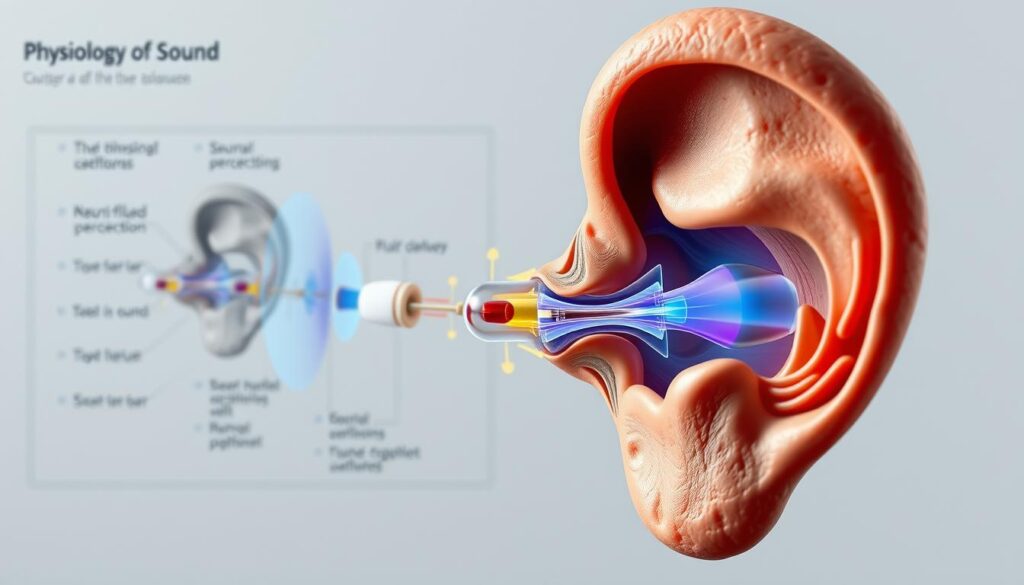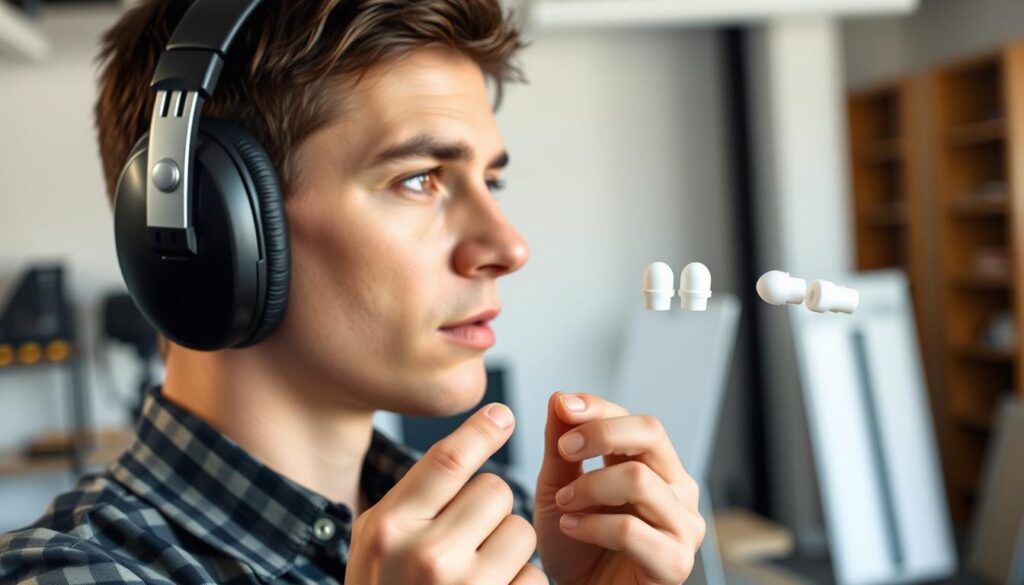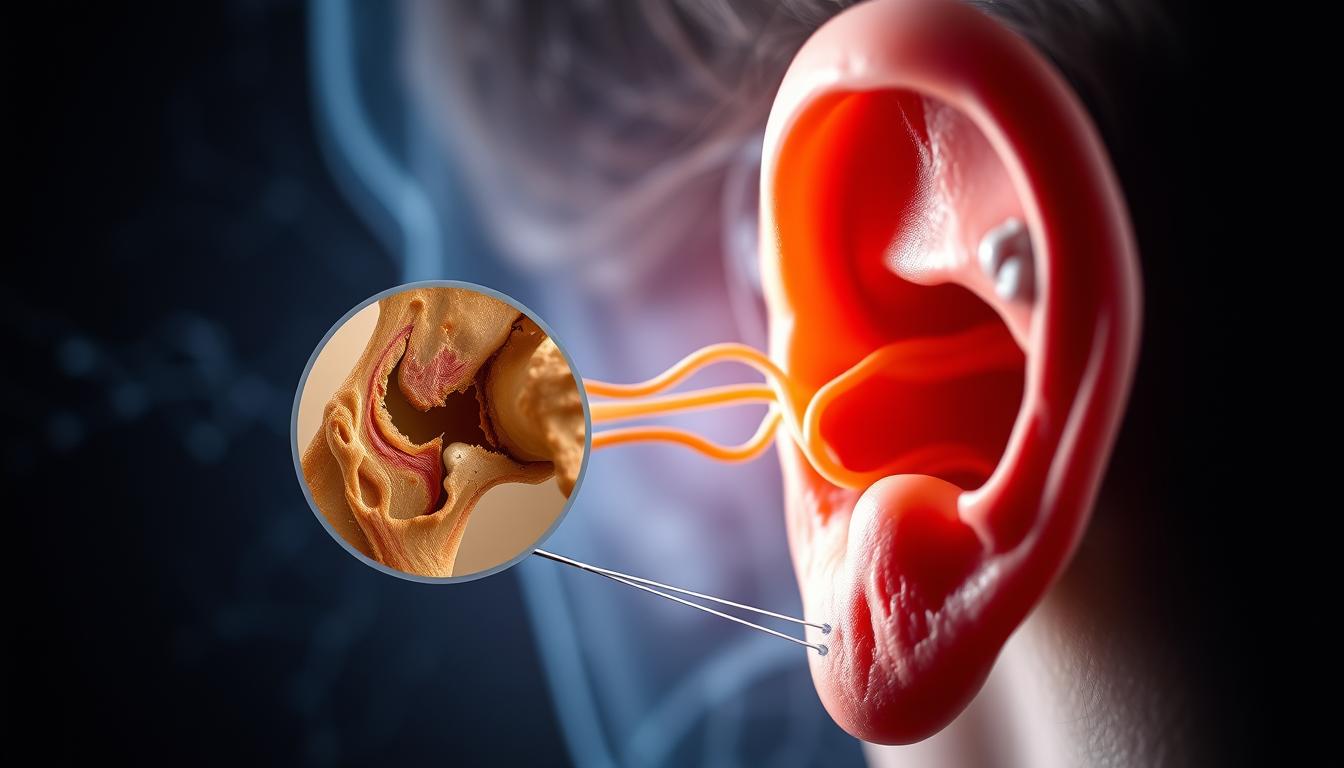Why Difficulty Hearing Happens and What You Can Do About It
Table of Contents
Ever had to ask someone to repeat themselves or struggle to hear in loud places? Difficulty hearing is more than a hassle—it’s a big challenge for millions in the US. It can creep up slowly, changing how we connect with the world.
In the United States, about 48 million people deal with hearing loss. This issue doesn’t pick favorites—it can hit anyone, from babies to the elderly. It’s caused by genes, loud noises, or just getting older. Knowing about hearing loss is the first step to managing it.
Your hearing health matters a lot. Spotting signs early can help you take steps to keep your hearing sharp. Many things can lead to hearing problems, from genes to our surroundings.
To get better results, you can benefit from the benefits of this nutritional supplement
Key Takeaways
- Hearing loss affects 20% of the US population
- Multiple factors can contribute to difficulty hearing
- Early detection is critical for effective management
- Hearing loss can occur suddenly or develop gradually
- Professional help can significantly improve hearing experiences
Understanding Hearing Loss: Types and Prevalence
Hearing loss affects millions of Americans. Knowing the different types can help you spot potential issues early. This way, you can get the right treatment.
Hearing loss mainly falls into three categories. Each has its own effects on how well you can hear:
- Sensorineural hearing loss
- Conductive hearing loss
- Mixed hearing loss
Sensorineural Hearing Loss
Sensorineural hearing loss is the most common, affecting about 90% of adults. This type happens when the inner ear or the nerve that carries sound gets damaged. It can be caused by:
- Getting older
- Genetics
- Too much noise
- Some medical conditions
Conductive Hearing Loss
Conductive hearing loss occurs when sound can’t get through the ear properly. It’s more common in kids. It’s often due to:
- Ear infections
- Fluid in the ear
- Earwax blocking the ear
- Abnormalities in the ear structure
Mixed Hearing Loss
Mixed hearing loss is a mix of sensorineural and conductive hearing problems. It needs a detailed check-up and a treatment plan that fits you.
About 48 million Americans have some hearing loss. It’s key to understand the different types.
By knowing about hearing loss, you can take steps to keep your hearing healthy. This way, you can get the right help when you need it.
Common Signs of Difficulty Hearing in Adults
Hearing problems can sneak up on you, often without you realizing it. They can make everyday talks tough. It’s key to spot these signs early to keep your life quality high.
Adults with hearing loss might notice a few things:
- Struggling to understand conversations in noisy places
- Frequently asking people to repeat themselves
- Turning up the TV or radio volume too high
- Difficulty figuring out where sounds are coming from
- Experiencing tinnitus (ringing in the ears)
Many people with hearing issues feel exhausted after social events. It’s hard to keep up with conversations, leading to stress and feeling left out.
“Hearing loss is not just about volume, but about clarity and comprehension.” – Audiology Expert
About 15% of American adults have some hearing trouble. Yet, 70% could use hearing aids, but only 20% do.
| Age Group | Hearing Loss Prevalence |
|---|---|
| 45-54 years | 5% |
| 55-64 years | 10% |
| 65-74 years | 22% |
| 75+ years | 55% |
If you’re having trouble hearing, see an audiologist. They can check if a hearing aid could help you hear better and live better.
Early Warning Signs in Children and Infants
Finding hearing problems early can really help a child grow. Ear infections and hearing loss can make it hard for kids to learn and talk. It’s important for parents and caregivers to know the signs.
Hearing issues show up in different ways as kids get older. Knowing these signs can help parents act fast to help with hearing problems.
Signs in Babies and Toddlers
Babies with hearing issues might act differently:
- Not startled by loud noises
- Failing to turn toward sound sources before 4 months
- Not responding when their name is called
- Delayed speech development
Signs in School-Age Children
Older kids might show more signs of hearing loss:
- Frequent requests to repeat instructions
- Difficulty following classroom conversations
- Increased volume when watching television
- Academic performance challenges
When to Consult a Healthcare Provider
If you notice hearing worries, see a doctor. Early help can really help with talking and learning.
| Age Group | Hearing Loss Prevalence | Intervention Recommendation |
|---|---|---|
| Newborns | 1 in 1,000 | Screening before 1 month |
| School-Age | 2-3 per 1,000 | Comprehensive hearing test |
Remember, about 75% of kids will get an ear infection by age 3. So, it’s key to check their hearing often.
How Your Ear Works: The Journey of Sound

Your ear is an amazing organ that turns sound waves into signals your brain can understand. Learning about hearing shows us how complex it is. It also helps us spot signs of hearing problems.
Sound starts its amazing journey in three main parts of the ear:
- Outer Ear: It catches sound waves and sends them into the ear canal
- Middle Ear: It makes the vibrations stronger and moves them through tiny bones
- Inner Ear: It changes sound vibrations into nerve signals
The human ear can hear sounds from 20 to 20,000 hertz. It’s most sensitive between 1,000 to 4,000 hertz. This range lets you hear everything from whispers to loud music. When sound waves hit your ear, they make your eardrum vibrate. This starts a series of detailed movements.
In your inner ear, the organ of Corti has special hair cells. These cells turn sound vibrations into nerve signals. They are very important for hearing. But, they can get damaged by loud noises, leading to hearing loss or problems.
The last step of hearing is when electrical signals go to your brain. Your brain then understands these signals as sounds. This whole process happens very quickly, showing how efficient human hearing is.
Medical Conditions Leading to Hearing Problems
Many medical conditions, age-related changes, and environmental factors can affect your hearing. Knowing these risks helps protect your ears and spot early signs of hearing loss.
Age-Related Hearing Loss
Age-related hearing loss, or presbycusis, happens as you get older. About 1 in 8 people in the United States face hearing challenges. It’s caused by the natural wear and tear of the inner ear.
- It starts around age 50
- It gets worse slowly over time
- It affects both ears the same
Noise-Induced Hearing Loss
Noise-induced hearing loss comes from loud sounds and long exposure to high decibels. Your ears can get permanent damage from:
- Workplace noise
- Loud music
- Industrial equipment
- Recreational activities with high sound levels
Disease-Related Hearing Loss
Several medical conditions can harm your hearing. Key health issues include:
- Diabetes (affects over 38 million Americans and can double hearing loss risk)
- Stroke (71% higher risk of sensorineural hearing loss)
- Hypertension
- Autoimmune disorders
Protecting your hearing requires understanding potential medical risks and taking proactive prevention measures.
Regular medical check-ups and hearing screenings can help catch and manage hearing problems early. This ensures better long-term hearing health.
Diagnostic Process and Hearing Tests
If you think you might have hearing loss, the first step is a detailed check-up. Your doctor will lead you through a series of tests. These tests aim to find out exactly what’s wrong with your hearing.
The steps in the diagnostic process are:
- First, you’ll see an otolaryngologist for a check-up.
- Then, they’ll ask you about your medical history.
- Next, they’ll examine your ears physically.
- After that, you’ll see an audiologist for more tests.
Audiologists use different tests to check your hearing:
- Pure Tone Audiometry: This test checks how well you can hear different sounds.
- Speech Audiometry: It tests how well you can understand spoken words.
- Tympanometry: This test looks at how well your middle ear is working and if there are any blockages.
For babies and young kids, special hearing tests are very important. The Centers for Disease Control and Prevention say all babies should be checked for hearing loss by one month old. If a baby doesn’t pass the first test, they need a full hearing test within three months.
These tests check the inner, middle, and outer ear to find where the hearing problem is. They help doctors create a treatment plan just for you.
Treatment Options and Hearing Aids
Hearing loss affects millions of Americans. Modern technology offers many solutions to improve your hearing. Advances in medical technology have changed how we deal with hearing problems. This brings hope and better communication for those with hearing challenges.
Choosing the right hearing solution depends on several factors. These include the type and severity of your hearing loss, your lifestyle, and personal preferences. Your healthcare provider can guide you through the different treatment options.
Digital Hearing Aids: Advanced Sound Enhancement
Digital hearing aids are the latest in hearing technology. They are far better than older models. These devices offer:
- Precise sound frequency customization
- Background noise reduction
- Multiple listening program settings
- Bluetooth connectivity
Cochlear Implants: Breakthrough Technology
For those with severe hearing loss, cochlear implants are a remarkable solution. These devices bypass damaged ear structures. They directly stimulate the auditory nerve. Unlike traditional hearing aids, cochlear implants can help people with profound hearing impairments experience sound in a new way.
Bone-Anchored Hearing Systems
Bone-anchored hearing systems offer a new approach for specific hearing loss conditions. They transmit sound through the skull. This can help individuals with:
- Single-sided deafness
- Conductive hearing loss
- Mixed hearing impairments
“Hearing technology continues to evolve, offering unprecedented opportunities for those experiencing hearing difficulties.” – Audiology Research Institute
Your journey to better hearing is unique. Talking to an audiologist will help you find the best hearing aid or implant for your needs.
Preventing Further Hearing Loss

Protecting your hearing is key to avoiding noise-induced hearing loss. About 20% of people who are exposed to loud sounds will suffer hearing damage over time. Knowing how to protect your ears can greatly lower your risk of permanent hearing issues.
Noise is a major cause of hearing damage. Sounds over 85 decibels can harm your hearing, like the noise of heavy traffic or loud music. Your ears are very sensitive and need careful protection in many places.
- Use noise-canceling headphones to minimize external sound
- Wear protective ear equipment in loud workplaces
- Limit exposure to high-decibel environments
- Maintain lower volume levels on personal devices
Workplace hearing protection is very important. If you work in places like construction sites, nightclubs, or workshops, you need ear protection. Employers should give out the right hearing protection gear to stop ear infections and hearing loss.
| Noise Level | Risk Level | Recommended Protection |
|---|---|---|
| Below 70 dBA | Safe | No special protection needed |
| 70-85 dBA | Low Risk | Monitor exposure time |
| Above 85 dBA | High Risk | Use ear plugs or earmuffs |
Getting regular hearing tests can spot early signs of hearing damage. The World Health Organization suggests getting a hearing screening every year, especially if you’re often in loud places. By being proactive, you can greatly lower your chance of permanent hearing loss.
Living with Hearing Loss: Practical Tips and Adaptations
Life with hearing loss can be tough, but there are many ways to keep up. With nearly 48 million Americans facing this issue, you’re in good company. Finding effective ways to adapt and thrive is key.
Improving communication starts with managing your hearing challenges. Work with an audiologist to create strategies for various settings. A hearing aid can greatly enhance your daily interactions.
- Create communication-friendly environments at home
- Use visual cues during conversations
- Optimize lighting to see facial expressions
- Position yourself strategically in group settings
Your home can be made more hearing-friendly. Here are some practical tips:
- Install carpet or rugs to reduce background noise
- Arrange furniture to facilitate face-to-face conversations
- Use assistive listening devices for televisions and phones
- Get alert systems for doorbells and alarms
Modern technology offers great solutions for hearing challenges. Assistive Listening Devices (ALDs) can greatly improve your communication. They range from personal amplifiers to advanced Bluetooth devices.
Don’t forget the importance of emotional support. Joining support groups can help you feel less alone. It also offers practical ways to cope with hearing loss.
Conclusion

Living with difficulty hearing doesn’t mean you can’t reach your goals. Modern tech and support systems open up new paths. About 25% of American adults aged 20-69 have hearing loss, showing you’re not alone.
Your journey ahead includes several important steps:
- Get help from professionals and doctors
- Try out the latest hearing technologies
- Find ways to communicate that work for you
- Stay positive and keep moving forward
New treatments for hearing loss are on the horizon. AI-powered hearing aids and brain-computer interfaces are changing how we tackle hearing issues. Gene therapy and regenerative medicine could lead to even more breakthroughs.
Hearing loss doesn’t limit what you can do. With the right tools and mindset, you can live a full and meaningful life. Keep learning, reach out for help, and believe in yourself.
Resources and Support for People with Hearing Difficulties
Dealing with hearing loss can be tough, but you’re not alone. The Hearing Loss Association of America (HLAA) has a lot to offer. They help millions with support and resources for managing hearing aids or cochlear implants.
Groups like the American Speech-Language-Hearing Association (ASHA) and the National Institute on Deafness and Other Communication Disorders are full of helpful info. They share educational materials and updates on hearing health. This includes info on advanced hearing aids and cochlear implants.
There’s also local support available. The SKI-HI Institute offers training in nearly all 50 states. They help families deal with hearing challenges. Plus, events like Walk4Hearing in 21 U.S. cities bring people together and raise awareness.
Your journey with hearing loss doesn’t stop after diagnosis or treatment. Joining support groups and attending virtual meetings like the HLAA Veterans Across America Chapter can help. Staying up-to-date with new technology also keeps your hearing health in check, ensuring a good quality of life.
FAQ
What are the most common types of hearing loss?
There are three main types of hearing loss. Sensorineural hearing loss happens when the inner ear or auditory nerve is damaged. Conductive hearing loss occurs when there’s a problem in the ear canal or middle ear. Mixed hearing loss is a mix of both sensorineural and conductive issues.
At what age do hearing difficulties typically begin?
Hearing loss often starts in the 40s or 50s. But, it can start earlier due to noise, health issues, or genetics. Significant changes usually happen after 65.
How can I tell if I’m experiencing hearing loss?
Signs include trouble hearing in noisy places and asking people to repeat themselves. You might turn up the TV or device volume. Feeling like others are mumbling or not clear is also a sign.
Are hearing aids my only option for treating hearing loss?
No, there are many treatments for hearing loss. Options include hearing aids, cochlear implants, and assistive devices. Medical treatments and surgery are also available.
Can hearing loss be prevented?
Some hearing loss can’t be prevented. But, you can lower your risk. Protect your ears from loud noises and avoid prolonged exposure. Use hearing protection and stay healthy. Regular hearing screenings are also important.
How do I know if a child has hearing difficulties?
Look for signs like not responding to sounds and delayed speech. Difficulty following instructions and speaking loudly are also signs. Early detection is key for support and development.
What causes noise-induced hearing loss?
Noise-induced hearing loss comes from loud sounds (85 decibels or higher). Sources include workplace machines, concerts, and personal audio devices. It can also happen from sudden, very loud noises.
Are there support resources for people with hearing loss?
Yes, many organizations offer support. The Hearing Loss Association of America and American Speech-Language-Hearing Association are examples. There are also online communities and support groups.
Can medications cause hearing loss?
Some medications can damage the inner ear and cause hearing loss. These include antibiotics, chemotherapy drugs, and high-dose aspirin. Always talk to your doctor about potential side effects.
How often should I get my hearing tested?
Adults should have a baseline test by age 21. Then, every 10 years until 50. After 50, tests should be every 3 years. Those at risk might need more frequent tests.







